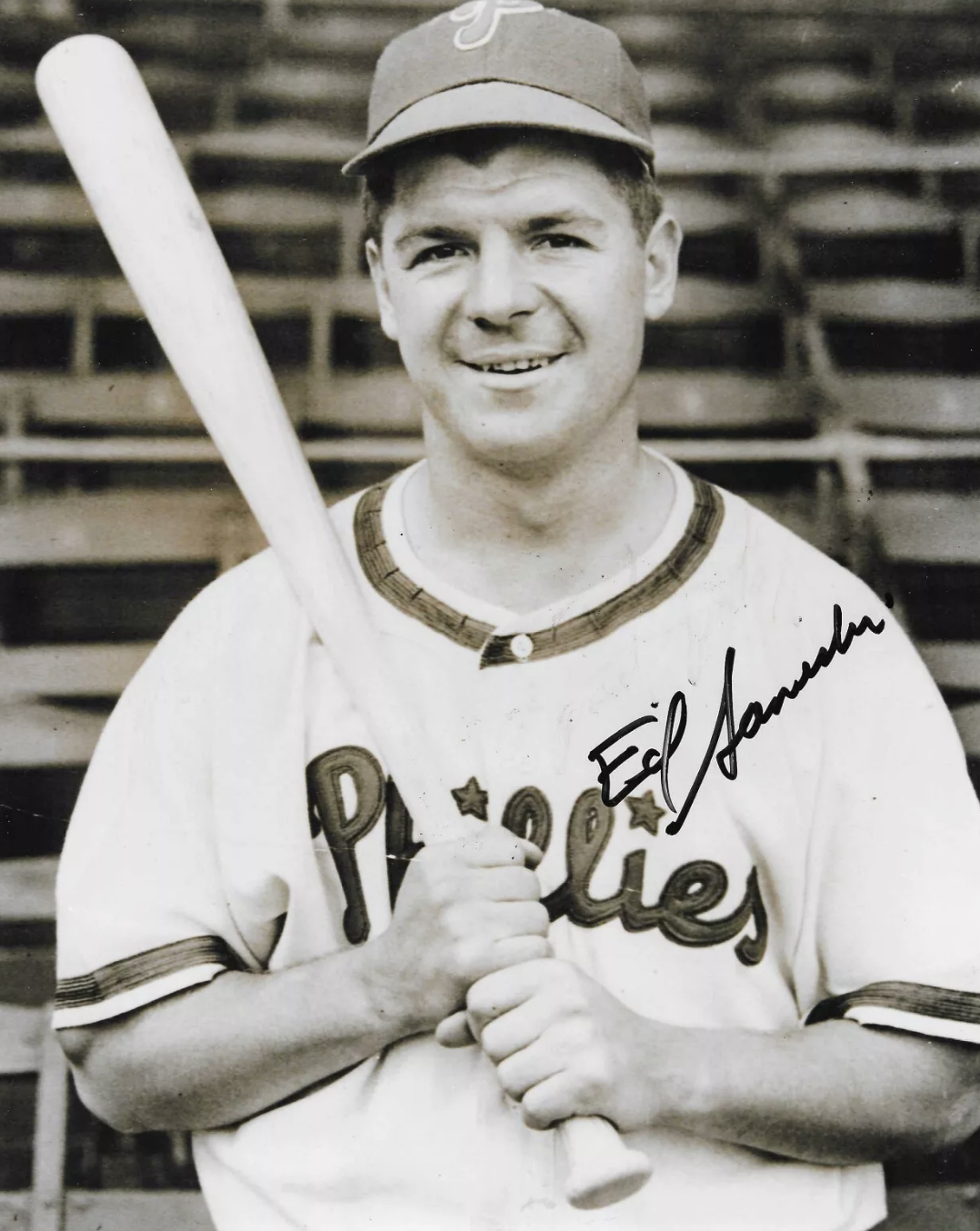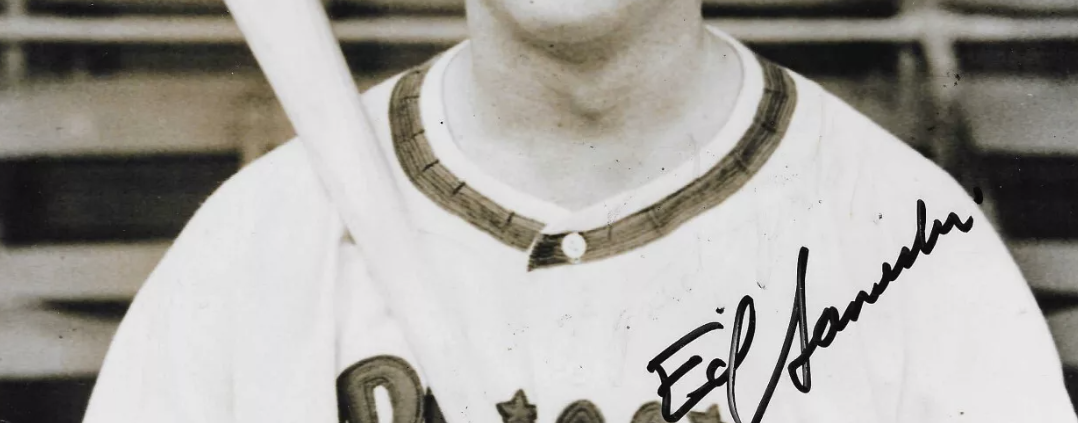September 14, 1949: Ed Sanicki rips home run off Rip Sewell in his first big-league at-bat for Phillies
 Ed Sanicki didn’t believe in saving his best for last.
Ed Sanicki didn’t believe in saving his best for last.
In his first official at-bat in a minor-league-exhibition game, the right-handed-hitting Sanicki hit a two-run homer off Vic Raschi in the fourth inning, helping the Wilmington Blue Rocks past the Binghampton Triplets, 6-3, in late April 1946.1
In the Blue Rocks’ first regular-season game a couple of days later, the outfielder drew a walk in his first trip to the plate and then slammed a home run over the left-field fence off Lancaster reliever Lyle Bliss in the second inning of a 17-1 spanking of visiting Lancaster.2
So perhaps it comes as no surprise that three years later Sanicki hit a home run in his first major-league at-bat. In fact, Sanicki’s first three major-league hits were all home runs. And to add to his impressive list of firsts, he hit a home run in his first game at the Philadelphia Phillies’ home field, Shibe Park.
Sanicki was not big (5-feet-9, 175 pounds) but showed consistent power during a seven-year minor-league career and over 20 major-league games. Sanicki graduated from Clifton (New Jersey) High School in 1941 and attended Seton Hall University for two years before joining the US Navy in 1943. He served as a signalman on a Liberty Ship for nearly four years (1943-46) before signing with the Phillies in 1946.
Sanicki’s first love was the Brooklyn Dodgers and he hoped to sign with them, but general manager Branch Rickey said he would sign Sanicki only if he made the team in spring training, after paying his own expenses. Sanicki told Rickey he couldn’t afford that, so Rickey wished him luck and gave him a cigarette lighter. “So I signed with the Phillies instead,” said Sanicki.3
He began his minor-league career with the Blue Rocks and played for Wilmington in the Class-B Interstate League for two seasons. Sanicki (pronounced SAN-a-key) hit 30 and 37 home runs respectively during the 1946 and 1947 campaigns, leading the league both years. In 1946 he bested runner-up Ed Sudol by two homers. (Sudol later joined the National League as an umpire, working 21 years and more than 3,200 major-league games.)
Sanicki was promoted to Toronto of the Triple-A International League in 1948. In the stronger competition, he hit only 21 homers and batted a meager .236. The next year in Toronto he made strides, hitting 33 homers and batting .268. On September 11, 1949, the Phillies called up Sanicki and Bill Glynn.4
Three days later, Sanicki made his major-league debut, in Pittsburgh. The Phillies took on the Pirates at Forbes Field in the second game of a two-game series. The day was partly cloudy with the temperature in the upper 60s. Junior Walsh took the mound for Pittsburgh as the clock struck 1:30 P.M. Eastern time. Walsh had one victory against three defeats coming into the contest. The Phillies countered with second-year right-hander Robin Roberts, who was looking for his 15th win.
The Phillies were in third place in the National League, 15 games behind St. Louis, which held a 1½-game lead over Brooklyn. Pittsburgh was mired in sixth place, 27½ games behind St. Louis. The only bright spot for the Pirates that season was outfielder Ralph Kiner, who had 48 home runs, including two the previous night along with six RBIs in an 11-6 win over the Phils.
A sparse crowd of 3,920 attended the mid-September game. The day got off to a rough start for Pittsburgh when Bill Nicholson’s two-out single scored Granny Hamner and Dick Sisler to give the visitors a 2-0 lead in the top of the first. Kiner cut the lead to 2-1 in the bottom half with a sacrifice fly to center field that scored Stan Rojek.
Walsh ran into some problems with the home-run ball in the top of the second. Mike Goliat and Hamner each slammed a solo shot to increase the lead to 4-1. Walsh left after the inning, having allowed three hits, four runs (two earned), and two walks. Vic Lombardi, a 5-foot-7 southpaw, took over in the top of the third.
It was still 4-1 in the top of the sixth when the Phillies added another run, this time on an RBI single off Lombardi by Willie Jones, scoring Stan Lopata to make it 5-1. The Pirates closed the gap to 5-4 in the bottom of the sixth off Roberts. Tom Saffell walked and scored on a triple by Johnny Hopp to make the score 5-2. Kiner then slammed his 49th homer to cut the lead to one run.
Lombardi struck out Roberts to start the top of the seventh, but failed to get any of the next five hitters out. The highlight was a two-run double by Del Ennis, plating Hamner and Richie Ashburn. After a walk to Lopata, Rip Sewell replaced Lombardi. The inning didn’t go any better for the Pirates, however, as pinch-hitter Buddy Blattner knocked in Ennis and Sisler with a single to left, widening the margin to 9-4. The inning ended mercifully for Pittsburgh on a line-drive double play.
Sanicki replaced the pinch-hitter Blattner and took over in right field. He had one putout in the seventh inning.
The score was still 9-4 when the Phillies came to bat in the ninth. Ennis and Lopata singled to bring up Sanicki. “I didn’t know what bat to use,” said Sanicki years later. “So I picked up an Andy Seminick bat, which had a thin handle and a heavy barrel. So, I don’t know, it was two and two or whatever it was, and I just swung and boom … this thing just lofted over ‘Greenberg Gardens.’”56
Sanicki caught two fly balls in the bottom of the ninth, and the Phils walked off with a 12-4 win.
After going 0-for-4 in a couple of games, Sanicki hit a home run against the Cardinals on September 19 off Howie Pollet, this one a two-run shot in the fourth inning at Sportsman’s Park. He added a sacrifice fly in the sixth, giving him three RBIs in the game.
Sanicki didn’t play again until September 28 in Philadelphia. In the bottom of the seventh he blasted an upper-deck homer to left off Sheldon Jones for his third home run of the year. He finished the season 3-for-13 – all three hits were homers –and seven RBIs. His slugging percentage was an other-worldly .923.
In 1950 Sanicki started the season with Triple-A Toronto. The Phillies wanted the right-handed hitter to give up his pull-hitting style and start using all fields. Sanicki struggled through the first three months of the season but was told he was going to be called up to be used as a defensive replacement. The next day in Rochester, he was attempting to make a catch and twisted his right knee, tearing several ligaments. Another player, Jackie Mayo, was called up instead. The date was July 18, Sanicki’s fifth wedding anniversary.7
Just short of three months later, the young Phillies team – dubbed Whiz Kids – played in the franchise’s first World Series since 1915. They were swept by the New York Yankees as Ed Sanicki watched from the stands.
The little slugger played in 13 games for Philadelphia in 1951, getting two hits in four at-bats. He was drafted by the Cincinnati Reds in the minor-league draft after the season and played for Houston and Tulsa in the Double-A Texas League. Sanicki retired after the 1952 season and went back to Seton Hall to finish his degree in education.
As of 2023, he had the highest career slugging percentage (.882) of any player with more than 20 plate appearances.
Sources
In addition to the sources cited in the Notes, the author consulted Baseball-Reference.com and Retrosheet.org.
https://www.baseball-reference.com/boxes/PIT/PIT194909140.shtml
https://www.retrosheet.org/boxesetc/1949/B09140PIT1949.htm
Photo credit: Ed Sanicki, courtesy of Jacob Pomrenke.
Notes
1 Marty Levin, “Blue Rocks Register 6-3 Victory Over Binghamton,” Wilmington (Delaware) Morning News, April 29, 1946: 14.
2 Jack Gibbons, “Rocks Crush Roses, 17-1, in Opener Before 4,106,” York (Pennsylvania) Dispatch May 2, 1946: 1.
3 Dennis Snelling. A Glimpse of Fame: Brilliant but Fleeting Major League Careers (Jefferson, North Carolina: McFarland and Company, 1993), 23.
4 Associated Press, “Phils Call Up Two from Toronto Now, Another in Spring,” Sioux City (Iowa) Journal, September 12, 1949: 12.
5 Snelling, 25.
6 Greenberg Gardens was the area between the original left-field fence and a fence installed 30 feet closer to home plate in 1947 to help new Pirates acquisition Hank Greenberg hit more home runs.
7 Snelling, 28.
Additional Stats
Philadelphia Phillies 12
Pittsburgh Pirates 4
Forbes Field
Pittsburgh, PA
Box Score + PBP:
Corrections? Additions?
If you can help us improve this game story, contact us.


